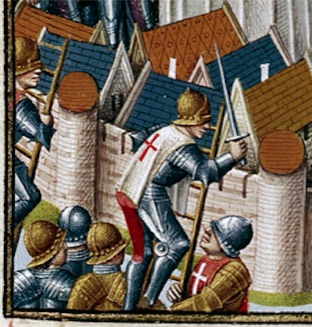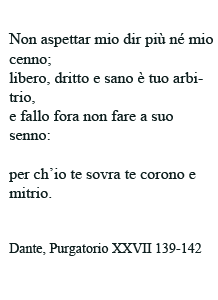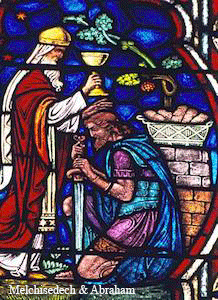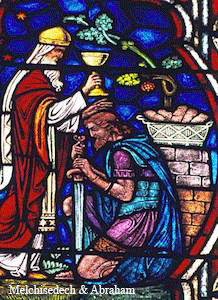Roncelin de Fos,
leader of the Conservative party

seal used by Roncelin de Fos
For the genealogy of Roncelin de Fos, this article draws on the work of Mr Daniel PRADIER in his book: The Templars.Comtat- Venaissin, Avignon, Pays d'Arles , historical study; Tours; 1986
The results of his research is used courtesy of the author, who was kind enough to send me one of his last available copies. I thank him warmly.
According to our current knowledge1, Roncelin de Fos, the alleged author of the secret statutes of the Knights Templar 2, was the youngest of four children of Lord Roger de Fos3 and Tiburgette de Baux, daughter of Guillaume III de Baux co-prince of Orange. Roncelin was born around 1205 in Marseille and died at the Templar House of Sainte-Eulalie-de-Cernon around 1280.
Thanks to various published documents such as the cartularies of the Templar order, we are starting to have a better knowledge of his career in the order. As far as we know today, the name of Roncelin de Fos appears for the first time in a deed dated 17 June 1242, where he is named as Master of the House of Tortosa in Syria in an arbitration award between the Templars and the Hospitalliers.4 He is Master in Provence between 1248 and 1250, then Master of England from 1251 to 1258, and again Master of Provence from 1260 to 1278.
Among the notable facts concerning the life of Master Roncelin, there is the part he played in the settlement of the inheritance of Guillaume III de Baux, co-prince of Orange, who was according to Daniel PRADIER the maternal grandfather of the Provençal Master. According to the act passed in the city of Orange in 1250, Roncelin de Fos came to receive the donation that Guillaume III de Baux had made in favor of the Templars.

seal of Guillaume III de Baux
In 1250, this donation was a controversial issue. Guillaume III de Baux, out of hatred for his uncle and his nephew and disregarding the will he had made in 1248, had given away to the Templars a part of their share of the inheritance. This situation drove Raymond I de Baux, Prince of Orange, to seize the entire inheritance after the death of William and to share it with his nephew.
The act passed February 12, 12655 reports a transaction between Raymond de Baux I and Raymond de Baux II, Lord of Suze, prince and co-prince of Orange, and Roncelin de Fos, Master of the Knights Templar in Provence, by which a settlement was found. Roncelin abandoned all rights of the Templar knights on the property they were bequeathed by Guillaume III de Baux. In compensation, Roncelin of Fos required that they give up to the Knights Templar of Provence 38 'saumées' (corresponding to 303 300 square meters) of farmlands in the territories of Camaret and Jonquières , and that they pay 16000 'sols viennois', a Provençal currency.
The family ties that bind Master Roncelin with the Baux family is one of the elements that lead us to believe that he was an active member of the mysterious Brotherhood of the Magi – which the lords of Baux led in Provence. Moreover the seal of the lords of Fos bore an eight-pointed star, as a mark of the commitment of this house to the faith of the Magi.
|
Nostradamus gives a description of the seal of the lords of the house Hyères Fos, which he says are a "very noble and very powerful race in Provence". "This seal bore “ on the one hand a lion with the words Sigillum Dominorum written in Gothic script, and the other the comet with sixteen rays of the princes of Baux, lords of Fos with these words ' de Areis' written in the same script, which is one may as well say the seal of the lords of Yères. But the star on their coat of arms has only eight golden rays on a blue shield, differentiating by this smaller number of rays the puisne and cadets from the chief leaders of the family. "Alphonse Denis, Hyeres Ancient and Modern, ed; Jeanne Laffitte, Marseille, 1999; p. 47 |
With such ascendancy, Roncelin de Fos was well positioned to lead the Conservative party within the General Chapter of the Temple. The 'Conservative' party was composed of the nobility that remained committed to the values of the upper aristocracy of the Holy Roman Empire, called in the Middle Ages the Ghibellines – challenged by the reformers from the Gregorian Church named the Guelphs.
The confrontation between the Gregorian church and the Carolingian church within the Catholic Church was at the source of many schisms during a large part of the middle Ages. It can also be an explanation for the breaking for the common rule of the Templar brothers, which seems to have happened with the writing of the Secret statutes.
In 1264, Roncelin de Fos received knight Raimbaud de Caron in the Commandery of Richerenches in Provence. Raimbaud de Caron later became Commander of Cyprus and was amongst the dignitaries of the Temple who stayed by the Grand Master Jacques de Molay up to his arrest in the enclosure of the Temple of Paris. He is presumed to be Roncelin de Fos' successor at the head of the Conservative party in the Temple. He died during the trial after the tortures inflicted by the inquisitors.
Finally, we will quote an excerpt from the deposition of the dignitary Geoffroy de Gonneville, Preceptor of Aquitaine and Poitou, which he made during the Templars trial on November the 15th, 1307. Asked about the origin of the wicked ritual of denying Christ and spitting on the cross, brother Geoffroy answered:
« Some say, in our order, that it was established by this master which was prisoner in the Sudanese jails, as I have related. Some say that that it was one of theses bad and perverse introductions by master Roncelin in the order’s statutes; others claim that it comes from the wicked statutes and doctrines of master Thomas Béraut; still others claim that we do it following the example or in memory of Saint Peter who denied the Christ three times. 7»
In 1882, Mr. Delaville le Roulx published documents from the records of the order of Malta 8. Among these documents, there is a deed dated October 1252, in which the Grand Master Thomas Bérard grants to several people a safe-conduct for Tripoli. At the end of this deed, brother Roncelin of Fos is mentioned as companion of the master. This deed published by Delaville le Roulx proves that Roncelin of Fos, the presumed author of the secret statutes of the Templar Knights order9, was close to the Grand Master and had the complete trust of Thomas Bérard.
|
This document reinforces the allegations of Geoffroy of Gonneville concerning the presumed authors of the secret practices introduced within the Knights Templars order.
Incidentally, we can add that in 1614 the archbishop of Saint-Trophime of Arles, Gaspard du Laurens (1603-1630), will have himself represented as a Magi on a painting that can still be admired in the cathedral of Arles in the chapel of the Three Magi.
by Jean-Pierre SCHMIT
notes
1) I would like to insist on the fact that the career and genealogy of Master Roncelin de Fos have not yet been totally mapped out. Our information is subject to change with new and contradictory facts. One of the difficulties in establishing the genealogy of the lords of Provence is their custom of naming their children as their ancestors to honor their memory. The case of Roncelin de Fos is typical in this respect since Roger II de Fos, Baron de Bormes (ca1230- ca 1286), married to Barrasse of Barras with whom he had a son named Roncelin de Fos (born circa 1265). This Roncelin, who will be affiliated to the Knights Templar in 1285, married in 1286 with Mabille Agoult. The lineage perpetuated the name of Roncelin de Fos up to the fifteenth century.
According to another source, A. DENIS, Ancient and modern Hyères, 1835, the master of the Knights Templar in Provence, Roncelin de Fos, would be the son of Amiel de Fos. In that case, Tiburgette de Baux, daugther of Guillaume III de Baux, would have been the wife of Roger de Fos, the brother of our Provençal master.
2) According to Daniel PRADIER, Roncelin of Fos is not the son of Amiel of Fos, he is his grand-son. Excerpt from his work The Knight Templars, Comtat-Venaissin, Avignon, Pays d’Arles, a historical study; Tours, 1986, P. 122: “ Amiel played the game well by paying homage to the Counts of Barcelona for the first time in the history of the Fos family, and, thus restoring peace in his lands. The act, passed on April 1196 in Perpignan, is in the files of Aix en Provence. On this document there is a triple pointed cross – which is the signature of Amiel de Fos who probably didn't know how to write. After these events, Amiel was entitled Grand Marquis by his vassals and by his villains of Hyères. He died around 1215. He had married Adelaide of Laidet, Dame of Lavera. They had six children.
Bertrand, the eldest, whose name is often found in the acts alongside the name of his father, died without offspring. Guy who was archbishop of Aix en Provence died in 1212. Roger was his third son - who we will go back to later in more detail. Mabile, the lady of Hyères, who was the soul of the Provençal resistance to the claims of Charles 1st of Anjou, married Rostaing d'Agoult, lord of Sault. There were also Hugotte who married Geoffrey Icart, co-lord of Hyères, and, finally, Cecile who probably did not live over the age of twenty.
Roger, the third son of Amiel, married Tiburgette of Baux, the daughter of Guillaume III of Baux, prince of Orange and of Valpurge, house of Agoult. Four children were born from their union. Philippe, who gave up the name of Fos to take up the coat of arms of his paternal grandmother, Lavera. He became Grand Seneschal of Provence under Charles II of Anjou. After him, came Guillaume who also allied with the Count of Provence and won for him important victories in Italy. Then there was the enticing Bellière, who aroused the passion of many troubadours before marrying one, the charming Boniface de Castellane, lord of Gabert. Finally, there was Roncelin, Master of the Knights Templar in Provence who was very probably born in Marseille (his father lived there since his uncle Bertrand lived alone in Hyères. Some historians, without any evidence, set his birthplace in Bormes les Mimosas?...). Born around 1205 and died in the House of the Temple of Sainte-Eulalie-de-Ceron around 1280,1290." The author gives for reference on page 121 note 7: De SAINT-ALLAIS; Nobiliaire universel de France, Tomes VII and IXX; Paris, republication of 1873/1874.
3) Daniel PRADIER, op. cit. The author gives as reference F. RAYBAUD Histoire de la province appelée de Provence qui était jadis de l'ordre du Temple. Dans l'histoire des grands prieurés et du prieuré de Saint-Gilles; publié à Nîmes par l'abbé C. NICOLAS ; 1905
4) Dr. L. Barthélémy. Inventaire chronologique et analytique des Chartes de la Maison de Baux; Marseille; Barlatier-Feissat; 1882; p.143, n°501
5) GAY, Hubert; GRAVA, Yves; PAOLI Jean-Marie; VIGOUREUX Anne-Marie. Histoire de Fos-sur-Mer. Aix-en-Provence; Éditions Edisud. 1977; p. 61
6) CARRAZ, Damien. L'Ordre du Temple dans la basse vallée du Rhône (1124-1312). Presses Universitaires de Lyon, 2005. p. 139
7) Deposition translated by G. LEGMAN; La Culpabilité des Templiers; Henri Veyrier Editeur; 1973; p. 74
8) J. Delaville le Roulx; Documents concernant les templiers, extraits des archives de Malte, Paris, Plon, 1882; pp 26-30
9) The historian Damien Carraz, in his work The Order of Temple in the Low Valley of the Rhône (1124-1312 ) p. 309, points out that master of Provence Roncelin of Fos was probably not a very good Latinist because in 1274 he has a notarial act written in Latin translated for him. If Roncelin dictated the secret statutes that bear his name, it is certainly not him who wrote them out. Even in the middle Ages, Latin remains a liturgical language, difficult to access for the secular knights. However, the Knights Templar did not lack of devoted chaplains to carry out the delicate task of translating in Latin these famous secret statutes.
A man in particular draws our attention. According to Damien Carraz, this man was the chaplain of Roncelin of Fos. He also was an Occitan at the head of the Templar house of Toulouse. We know that the Knight Templars had the custom of opening the General Chapter with a chaplain of the Temple introducing the zodiacal figure of the winter solstice, which represented the Holy Spirit going down on the apostolic college at Pentecost – a tradition in accordance with liturgical customs of the regular canons of Saint-Sernin of Toulouse. This discreet man, familiar with the liturgy of Toulouse and with Roncelin de Fos, certainly had a leading spiritual influence within the order.
This man is the chaplain Knight Templar Guilhem of Saint Jean, whom pope Nicolas IV will appoint archbishop of Nazareth on July 18th, 1288. He will be one of last holders of this office in the Holy Land: Guilhem de Saint-Jean dies on July 28th, 1290, only ten months before the definitive loss of the Holy Land with the fall of the port of Saint Jean of Acre on May 18th, 1291. It will take seven centuries before the gravestone of our archbishop Knight Templar is rediscovered in 1962 at Saint John of Acre.





















